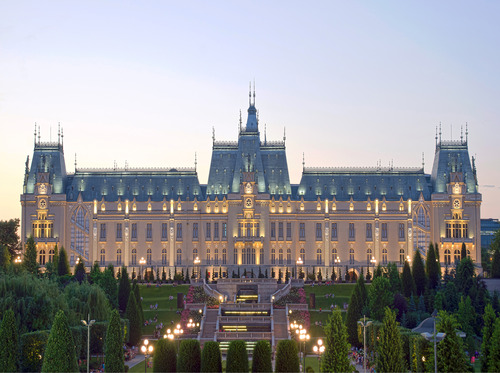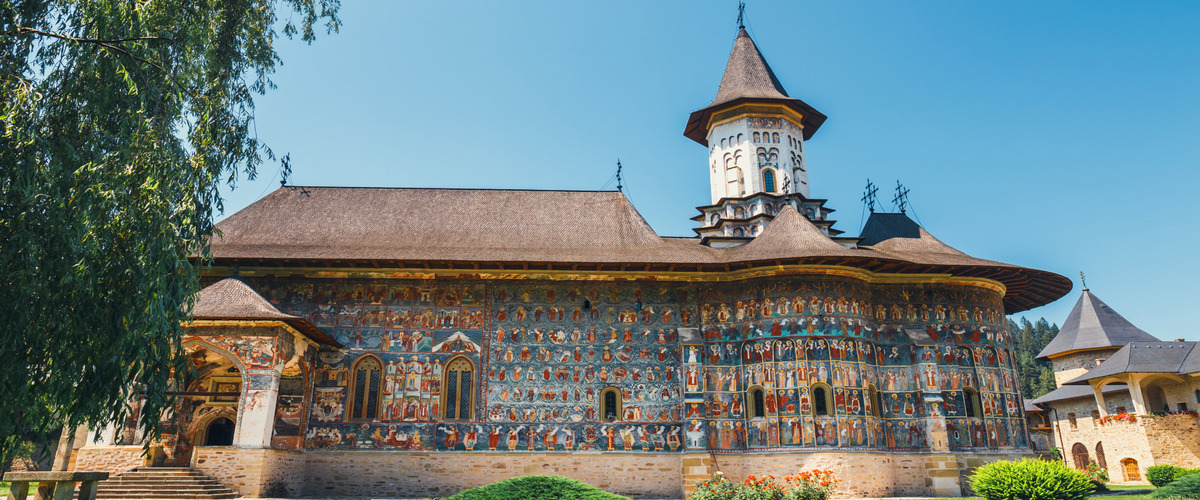The Moldova region is a fascinating blend of picturesque landscapes, historic strongholds, and traditional artistry. Here are plenty of UNESCO Heritage Sites, such as the painted monasteries and wooden churches.
The roads are going into the mountains, the landscape becomes more and more spectacular. In the Northernmost place of Romania, we find one of the best examples of the communion between the people and the environment: Maramures region. Mostly rural, each village is in itself a living museum, populated with people whose life unfolds quite naturally. Each settlement seems to be a "village museum", with unpaved lanes, guarded on either side by farmhouses and buildings made entirely of wood - genuine monuments of folk art and architecture.
This tour will show you vivid mural paintings unique in the world, elaborate woor carving techniques that are kept since decades ago and majestic religious establishments where you can rest your soul and be thankful that you can see such beautiful places!
Departures: all year
Duration: 6 days / 5 nights
PRIVATE TOUR: by car / minivan

The tour starts in Iasi, the historical capital of Moldova region.
First thing on our list:
Downtown walk to Iasi and a look inside the Palace of Culture - with more than 8000 paintings, the Art Museum has the largest collection in Romania; in the Ethnographic area one can find the collection of 11.000 pieces; decorative art, ancient books, pottery remains from the antiquity (Cucuteni culture), even a 70.000-year-old Middle Paleolithic era mammoth skull worth a visit to the History Museum;
Also, the “Trei Ierarhi” church reflects the aspiration of the founder towards the byzantine world. The extraordinary decorations in stone which adorns the facades, from bottom to the top of the derricks, combining the Byzantine tradition with the characteristic elements of the art of Moldava and Wallachia were standing to the decision of submitting the building on the UNESCO Tentative List in 1991.
After the city tour you have accommodation at 4* hotel.

Leave the city and drive to Suceava. Most of the Moldovan landscape consists of a hilly region crossed by many streams and rivers, with the elevation decreasing gradually from North towards the South; agricultural fields, orchards and vineyards completes the images of Moldova region.
Stop at Cotnari vineyard. The place is a once-famous wine region from the Romanian Moldova; rivaling the Hungarian Tokay, the wine made here was fashionable in Paris at the end of the 19th century. The vineyard origins date back to before Romanian Moldova became a state, with evidence that the Thracian tribes populating the area cultivated vines, and first written mentions from 1250, before the foundation of the Moldavian Principality. For many centuries Cotnari wines were the main choice for rulers of the Principality.
Cotnari is a premium wine producer, following a fusion of tradition (the only use local grape varieties) with modern technologies. The quality comes from the limitation of the average grape production/ha. The vineyards comprise 1700ha, the fruit of an ancient mining and winery occupation. The combination between the mild and protective climate with soil with sandy texture and richness in humus have made created conditions to obtain unique Romanian wines as the famous white “Grasa de Cotnari”, one of the best-selling wines in Romania. Since the establishment from 1949, the company was multiple awarded at national and international contests.
Wine tasting and late lunch at Cotnari. Then we arrive in Suceava and we will take a quick tour. With the exception of the historic center of Sighisoara, Sfantul Gheorghe Monastery in Suceava is the only UNESCO urban monument in Romania.
Accommodation at 4* hotel.

In the European art, the exterior mural painting of the churches in the North of Moldova is a unique artistic representation in Byzantine art. The paintings completely cover the facades of the churches, achieving at the same time a perfect symbiosis between color and architectural style through the ingenious use of architectural spaces. At the same time, there is a perfect harmony between the colors of the exterior painting and the landscape. There are eight such churches included in UNESCO Heritage List and we will visit a few of them today!
Sucevita Monastery: The interior and exterior walls of the Church of the Sucevita Monastery are entirely decorated with mural paintings of the 16th century, and this church is the only one to show a representation of the ladder of St John Climax. The style is a harmonious combination of Byzantine and Gothic art elements, to which are added architectural elements of the old wooden churches in Moldova, as well as of the Wallachian style (the two verandas by the entrances).
Voronet Monastery: one of the most important churches erected by the famous Stephen the Great in 1488. The outside painting is considering the most valuable artistic asset, a masterpiece; The biblical scenes, combined with folk elements depicted here are considered lively, natural, embodying the most successful artistic ensemble of Moldovan feudal art. On the south wall we find the most abundant famous color known as Voronet blue - a mysterious natural pigment that changes from blue to green depending on the humidity of the environment. This blue is considered unique by artists in the world and is compared to Rubens red or Veronese green, thus the surname of the composition as the “Eastern Blue Sistine Chapel”
Having a long history behind, the traditional activity of pottery included the village of Marginea on our list of sites to visit; popular for the black ceramic pottery, this is the only place in the world where the black color is obtained without adding anything to the clay paste.
Accomodation in a traditional guesthouse in the area.

Continue towards Moldovita Monastery – Medieval art at its purest. Along with the ones at Voronet, Moldovita’s frescoes, have best preserved their colors which are astonishingly fresh and vivid. The green, which represents the earth line, and the blue of the background associates the structure to the grass of the lawn around it and to the sky against which it projects, making the viewer think the church emerged from the life blood of the earth, reflecting the surrounding nature.
The wooden churches from Maramures were included in UNESCO World Heritage List in 1999. They represent the happy synthesis between major architectural elements from Eastern and Western Europe, to which is added the synthesis between the plan of Byzantine origin and the Gothic forms that appear in the form of an original local architecture. The constructions are made of wood, according to the Blockbau system, according to a traditional technique, which denotes a perfect knowledge of the material.
The church from Ieud is the oldest of its kind in Romania (1610-1621 – based on the research of the wood used for the construction). The high tower has a complex of Gothic with Orthodox features, whereas the interior murals were done directly on wood. An extraordinary old book, the Codex of Ieud dated back since the 16th century (1391 upon other specialists) was discovered in 1921 under the rooftop of the church. Inside of the church we see priceless collection of wooden icons, as well as icons painted on glass, and carpets with geometric motifs, painted with vegetal and mineral colorants.
The church from Poienile Izei was built using fir beams, the roof having double eaves. The paintings are very well preserved, and include big scenes in simple frames, the colors being more important for the unity of the paintings than the actual composition of the scenes.
Accommodation in Breb village in Maramures for tonight, placed in a silent and tranquil environment.

The church from Desesti was built in 1770 on the site of an older church. The construction has preserved its original form. The interior paintings done in 1780 are remarkably well-preserved, illustrating classical Biblical themes, but adding also some particular scenes. The shades of red are predominatng, the chromatic pattern being underlined by the white Maramures towels that adorn the church furniture. One of the most beautiful scenes is the River of Fire, represented on the southern wall. Relics of the Celtic civilization (tombstone crosses) can be found in the churchyard cemetery.
We’re leaving the main area of Maramures land, going south across the mountains to Lapus land, also part of Maramures.
The church from Surdesti was built in 1721, entirely from oak wood and has one of the highest wooden steeples in the world, an easier way for the prayers to access the heaven, according to the locals. The beautiful iconostasis is organized in a pyramidal structure, its icons featuring golden backgrounds and richly sculpted frames.
The road continues to wind in large loops up and down the massive Carptathian Mountains, offering us marvelous panoramic views, now and then. After driving alog Bistrita river valley for a while we take a narrow and steep climb road, up to 1600m altitude, on Rarau massive. Here we have a view over the the East, looking down at the secular Slatioara forest, submitted to the UNESCO Tentative List in 1991. Spread over 1064ha, the forest is characterized by old beech mixed with fir trees over 50 meters high (some of them reaching 400 years old). In the upper altitude they are replaced here and there by spruce forests. Large amounts of deadwood and old trees characterize the forests as very natural, untouched by civilization.
Descend and continue the drive; we’re back in Moldova.
Accommodation at 4* traditional guesthouse.

On our last day we will head back towards the Moldavian plains but we will visit two more interesting monasteries, different than the ones we have seen yet!
Neamt Monastery – one of the oldest in Moldavia (14th century), it represents an important monastic establishment of the Middle Ages, whose main church constitutes the most representative example of the Moldavian style of the time of Stephen the Great in religious architecture, remarkable for the planimetric and spatial solutions that have been found. Triconch plan forms a sanctuary, naos, funerary chamber, narthex and exonarthex, with a typically Moldavian vaulting system. Outside, the harmony of decorations and shapes is supported and marked by the fragmented roof in accordance with the interior structure. of the vaulting system. The monastery as a whole comprises an enclosure with a bell tower and a small monastic village. From the beginning it was one of the most important centers of culture in Moldavia, through the manuscript writing school and its printing press.
Agapia Monastery – It is the only monastic settlement in the country that bears the name of “Christian love”, which comes from the Greek “agapis”. The monastery is famous around the world due to its interior frescoes painted in 1858 by the great Romanian painter Nicolae Grigorescu (one of the founders of modern Romanian painting).
Drive back to Iasi in the afternoon. End of tour.
From 1190/EUR/pers
*contact us for a personalized quotation
- Professional guide assistance, English speaking (or other languages upon request), during the whole trip;
- Transport by private modern AC car/mini-van (fuel and parking fees incl);
- Airport pick-up/drop off from the airport of Iasi (if the tour starts and ends at the airport - upon request);
- 5 night accommodation, breakfast included, in 3* and 4* hotels and rural guesthouses;
- One lunch and winetasting session at Cotnari.
- Entrance fees to the touristic attractions included in the itinerary;
- Photography fee;
- Meals, other than those mentioned in the itinerary;
- Other expenses (such as souvenirs, room service, tips and so on).





.png)




